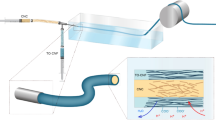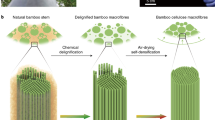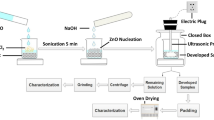Abstract
With a commitment to environmental protection, sustainable practices and ethical standards, there is compelling motivation to replace animal feathers and wool with synthetic materials that mimic the natural curl structure of animal fibres. However, the fabrication of these curved structures remains challenging due to inherent limitations in fibre spinning technologies. Here we develop a grid-induced homogeneous turbulence spinning system to efficiently spray the spinning solution, resulting in the mass production of highly curved nanofibres (HCNFs). A garment made with HCNFs offers excellent overall performance in terms of wearability, comfort, porosity (~99.60%), weight, thermal conductivity, moisture permeability and breathability. Furthermore, the garment exhibits a superior clothing insulation value (measured in CLO) of 0.31 CLO mm−1 at 0 °C, which is twice that of an 850-fill-power goose-down garment (0.15 CLO mm−1). Moreover, the results of a life cycle impact assessment demonstrate that HCNFs made of polyvinyl butyral show notable sustainability advantages over 850-fill-power down across 14 indicators, including mineral resource scarcity, land use, ecotoxicity, water consumption and human toxicity (eight indicators are less than 5% of those for down). Our findings not only underscore the advantages of nanofibres with highly curved structures but also introduce sustainable materials that outperform traditional down, making them suitable and sustainable for mass-market production.
This is a preview of subscription content, access via your institution
Access options
Access Nature and 54 other Nature Portfolio journals
Get Nature+, our best-value online-access subscription
$32.99 / 30 days
cancel any time
Subscribe to this journal
Receive 12 digital issues and online access to articles
$119.00 per year
only $9.92 per issue
Buy this article
- Purchase on SpringerLink
- Instant access to full article PDF
Prices may be subject to local taxes which are calculated during checkout




Similar content being viewed by others
Data availability
The related data are publicly available via figshare at https://doi.org/10.6084/m9.figshare.29372024 (ref. 47).
Code availability
The related codes are publicly available via Zenodo at https://doi.org/10.5281/zenodo.15672497 (ref. 48).
References
Williams, L. E. & Bargh, J. A. Experiencing physical warmth promotes interpersonal warmth. Science 322, 606–607 (2008).
Hsu, P.-C. et al. A dual-mode textile for human body radiative heating and cooling. Sci. Adv. 3, e1700895 (2017).
Zhang, X. A. et al. Dynamic gating of infrared radiation in a textile. Science 363, 619–623 (2019).
Hunter, L. in Handbook of Natural Fibres 2nd edn, Vol. 1 (eds Kozłowski, R. M. & Mackiewicz-Talarczyk, M.) 279–383 (Woodhead Publishing, 2020).
Moazzem, S., Crossin, E., Daver, F. & Wang, L. Life cycle assessment of apparel consumption in Australia. Environ. Clim. Technol. 25, 71–111 (2021).
Zhou, Y., Bao, W., Yan, F. Y., Zhang, Y. & Wang, L. Carbon footprint and water footprint assessment of down jackets. AATCC J. Res. 10, 300–310 (2023).
Tóth, P., Bódi, L., Maros, K., Szűcs, E. & Janan, J. Blood corticosterone levels in growing geese around feather gathering. Acta Vet. Hung. 60, 477–487 (2012).
Xi, L., Guo, Z. W. & Shi, Z. F. Effects of large-scale duck farms on the air and water environment. Hubei Agric. Sci. 53, 3124–3127 (2014).
Kozák, J., Gara, I. & Kawada, T. Production and welfare aspects of goose down and feather harvesting. Worlds Poult. Sci. J. 66, 767–778 (2010).
Chen, X.-J. & Fang, G. Analysis on China’s down jacket market based on the SCP paradigm. In Proc. 2019 International Conference on Management Science and Industrial Engineering (eds Wang, V. et al.) 111–116 (Association for Computing Machinery, 2019).
Tesfaye, T., Sithole, B. & Ramjugernath, D. Valorisation of chicken feathers: a review on recycling and recovery route—current status and future prospects. Clean Technol. Environ. Policy 19, 2363–2378 (2017).
Wu, M. et al. Biomimetic, knittable aerogel fiber for thermal insulation textile. Science 382, 1379–1383 (2023).
Peng, Y. & Cui, Y. Advanced textiles for personal thermal management and energy. Joule 4, 724–742 (2020).
Wu, H., Cai, H., Zhang, S., Yu, J. & Ding, B. Ultralight, superelastic, and washable nanofibrous sponges with rigid-flexible coupling architecture enable reusable warmth retention. Nano Lett. 22, 830–837 (2022).
Liu, Z., Lyu, J., Fang, D. & Zhang, X. Nanofibrous Kevlar aerogel threads for thermal insulation in harsh environments. ACS Nano 13, 5703–5711 (2019).
Cadieu, E. et al. Coat variation in the domestic dog is governed by variants in three genes. Science 326, 150–153 (2009).
Emsen, I. M. The approach to frostbite in Turkey: a retrospective study. Can. J. Plast. Surg. 14, 21–23 (2006).
Lasisi, T. et al. Human scalp hair as a thermoregulatory adaptation. Proc. Natl Acad. Sci. USA 120, e2301760120 (2023).
Cai, L. et al. Temperature regulation in colored infrared-transparent polyethylene textiles. Joule 3, 1478–1486 (2019).
Zhuang, X., Shi, L., Jia, K., Cheng, B. & Kang, W. Solution blown nanofibrous membrane for microfiltration. J. Membr. Sci. 429, 66–70 (2013).
Hsu, P.-C. et al. Radiative human body cooling by nanoporous polyethylene textile. Science 353, 1019–1023 (2016).
Wang, N., Han, S., Liu, L., Lu, K. Z. & Zhang, X. The continuous flexible three dimensional curly carbon-based hybrid nanofibers with good resilience and electrochemical performance. Mater. Des. 147, 114–121 (2018).
Jing, X., Wang, Y., Wu, D. & Qiang, J. Sonochemical synthesis of polyaniline nanofibers. Ultrason. Sonochem. 14, 75–80 (2007).
Guo, J. et al. Hypocrystalline ceramic aerogels for thermal insulation at extreme conditions. Nature 606, 909–916 (2022).
Li, Z. et al. High-throughput production of kilogram-scale nanofibers by Kármán vortex solution blow spinning. Sci. Adv. 8, eabn3690 (2022).
Thoppey, N. M., Bochinski, J. R., Clarke, L. I. & Gorga, R. E. Edge electrospinning for high throughput production of quality nanofibers. Nanotechnology 22, 345301 (2011).
Wang, S. et al. Direct synthesis of polyimide curly nanofibrous aerogels for high-performance thermal insulation under extreme temperature. Adv. Mater. 36, 2313444 (2024).
Liu, Z., Ang, K. K. J. & He, J. Needle-disk electrospinning inspired by natural point discharge. J. Mater. Sci. 52, 1823–1830 (2017).
Varabhas, J. S., Chase, G. G. & Reneker, D. H. Electrospun nanofibers from a porous hollow tube. Polymer 49, 4226–4229 (2008).
Finefrock, S. W. et al. Measurement of thermal conductivity of PbTe nanocrystal coated glass fibers by the 3ω method. Nano Lett. 13, 5006–5012 (2013).
Zeng, X. et al. A combination of boron nitride nanotubes and cellulose nanofibers for the preparation of a nanocomposite with high thermal conductivity. ACS Nano 11, 5167–5178 (2017).
Ramzan, M., Rafiq, A., Chung, J. D., Kadry, S. & Chu, Y.-M. Nanofluid flow with autocatalytic chemical reaction over a curved surface with nonlinear thermal radiation and slip condition. Sci. Rep. 10, 18339 (2020).
Zhang, X. et al. Flexible and thermal-stable SiZrOC nanofiber membranes with low thermal conductivity at high-temperature. J. Eur. Ceram. Soc. 40, 1877–1885 (2020).
Stark, C. & Fricke, J. Improved heat-transfer models for fibrous insulations. Int. J. Heat Mass Transf. 36, 617–625 (1993).
Shuakat, M. N. & Lin, T. Direct electrospinning of nanofibre yarns using a rotating ring collector. J. Text. Inst. 107, 791–799 (2016).
Sanchaniya, J. V. et al. Preparation and characterization of non-crimping laminated textile composites reinforced with electrospun nanofibers. Nanomaterials 13, 1949 (2023).
Pavia, F. & Curtin, W. A. Optimizing strength and toughness of nanofiber-reinforced CMCs. J. Mech. Phys. Solids 60, 1688–1702 (2012).
Wang, H. et al. Ultralight, scalable, and high-temperature–resilient ceramic nanofiber sponges. Sci. Adv. 3, e1603170 (2017).
Rissanen, S. & Rintamäki, H. Thermal responses and physiological strain in men wearing impermeable and semipermeable protective clothing in the cold. Ergonomics 40, 141–150 (1997).
Wang, Z. et al. Self-sustaining personal all-day thermoregulatory clothing using only sunlight. Science 382, 1291–1296 (2023).
Rathjen, N. A., Shahbodaghi, S. D. & Brown, J. A. Hypothermia and cold weather injuries. Am. Fam. Physician 100, 680–686 (2019).
Hsu, S.-H., Woan, K. & Sigmund, W. Biologically inspired hairy structures for superhydrophobicity. Mater. Sci. Eng. R Rep. 72, 189–201 (2011).
Ding, C. et al. A super-breathable “woven-like” protein nanofabric. ACS Appl. Bio Mater. 3, 2958–2964 (2020).
Zhang, L.-Z. A fractal model for gas permeation through porous membranes. Int. J. Heat Mass Transf. 51, 5288–5295 (2008).
Zhang, Z. & Liu, B. Y. H. Experimental study of aerosol filtration in the transition flow regime. Aerosol Sci. Technol. 16, 227–235 (1992).
Goldman, R. F. Clothing design for comfort and work performance in extreme thermal environments. Trans. N. Y. Acad. Sci. 36, 531–544 (1974).
Cheng, Z. et al. Dataset for biomimetic nanofibers for sustainable thermal insulation. figshare https://doi.org/10.6084/m9.figshare.29372024 (2025).
Cheng, Z. et al. Code supporting the method and analysis in biomimetic nanofibers for sustainable thermal insulation. Zenodo https://doi.org/10.5281/zenodo.15672497 (2025).
Acknowledgements
This work was supported by the National Natural Science Foundation of China (NSFC) under grant numbers 52421001 (H. Wu), 52388201 (H. Wu), 12388101 (L.Z.), 92472106 (H. Wu), 52325312 (H. Wu), 92252104 (L.Z.) and 12302285 (Z. Cui). We sincerely thank J. Tian for his assistance with model checking and validation. We acknowledge L. Chen and Y. Shi for their valuable guidance in the carbon emissions calculations and for providing access to the GaBi and Ecoinvent databases. We thank H. Zhang for his advice in optimizing the production process through the application of AI and big data technologies. We thank S. Gao for his cooperation in the fabrication of the spinning equipment. We thank X. Liu for his cooperation in participating in the testing under low-temperature conditions. We thank B. Tian and F. Huang for their advice on fitting the relationship between curliness and porosity.
Author information
Authors and Affiliations
Contributions
H. Wu, L.Z. and S.Z. conceived the idea and supervised the research. H. Wu and Z. Cheng designed the experiments. Z. Cheng and Z. Cui designed and constructed the experimental system. Y. Liu, H. Wang, Z. Cheng and Z.X. performed the product LCA. Z. Cheng, Z. Cui, Z.L., S.G., H.K. and R. Zhou performed the modelling and simulations. Z. Cheng, Z. Cui, H.K., J.S., R. Zboray, R. Zhou, M.F., Y. Li, Y.Z., Y.Y., S. Lu, R.Y. and C.-Y.Y. synthesized the specimens and analysed the results of different characterization methods. H. Wu, S. Li, G.Z. and Z.X. participated in the industrialization of the technology and the global promotion of the product. H. Wu, L.Z., S.Z., Z. Cheng, J.S. and Z.L. contributed to writing the paper. C.M. provided professional English editing and language polishing of the paper.
Corresponding authors
Ethics declarations
Competing interests
H. Wu and Z. Cheng confirm that patents were filed for this work through Tsinghua University. The other authors declare no competing interests.
Peer review
Peer review information
Nature Sustainability thanks Chenxi Sui, Xiaoming Tao and the other, anonymous, reviewer(s) for their contribution to the peer review of this work.
Additional information
Publisher’s note Springer Nature remains neutral with regard to jurisdictional claims in published maps and institutional affiliations.
Supplementary information
Supplementary Information
Supplementary Texts 1–7, Figs. 1–42, Tables 1–19 and refs. 1–46.
Supplementary Video 1
Animation of GHTS method.
Supplementary Video 2
Demonstration of HCNF preparation.
Supplementary Video 3
High-speed camera demonstration of a large-scale preparation process for HCNFs.
Supplementary Video 4
CFD simulations for nanofibre curling under GHT.
Supplementary Video 5
Compression experiments of highly curved nanofibrous materials at 293 and 80 K.
Supplementary Video 6
Safety testing of HCNF garment under blizzard conditions.
Supplementary Video 7
Warmth testing of HCNF garment in a low-temperature environment.
Rights and permissions
Springer Nature or its licensor (e.g. a society or other partner) holds exclusive rights to this article under a publishing agreement with the author(s) or other rightsholder(s); author self-archiving of the accepted manuscript version of this article is solely governed by the terms of such publishing agreement and applicable law.
About this article
Cite this article
Cheng, Z., Cui, Z., Li, Z. et al. Biomimetic nanofibres for sustainable thermal insulation. Nat Sustain 8, 957–969 (2025). https://doi.org/10.1038/s41893-025-01604-x
Received:
Accepted:
Published:
Issue date:
DOI: https://doi.org/10.1038/s41893-025-01604-x



